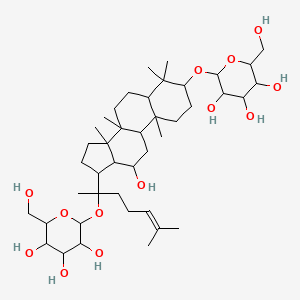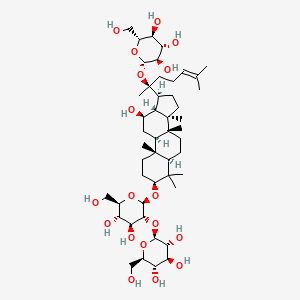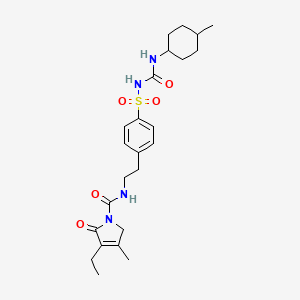
Glimepiride
概要
説明
グリメピリドは、スルホニル尿素系に属する糖尿病治療薬であり、主に2型糖尿病の治療に処方されます。 メトホルミンは確立された安全性と有効性があるため、メトホルミンと比較して第二選択薬とみなされます 。 グリメピリドは、主に膵臓からのインスリン分泌量を増加させることによって作用します 。 グリメピリドは1979年に特許を取得し、1995年に医療用として承認されました .
作用機序
グリメピリドは、インスリン分泌促進薬として作用します。 ATP感受性カリウムチャネルを阻害することで、膵臓のβ細胞からのインスリン分泌を刺激し、β細胞の脱分極とそれに続くインスリン分泌を引き起こします 。 さらに、細胞内インスリン受容体の活性を高め、インスリンに対する体の反応を強化します .
生化学分析
Biochemical Properties
Glimepiride stimulates insulin release from pancreatic β-cells and may act via extrapancreatic mechanisms . It is administered once daily to patients with type 2 diabetes mellitus in whom glycemic control is not achieved by diet and exercise alone .
Cellular Effects
This compound lowers blood glucose by stimulating insulin secretions from functioning pancreatic beta cells and by inducing extra-pancreatic effects, thereby decreasing insulin resistance . It potentially binds to ATP-sensitive potassium channel receptors on the pancreatic beta cell surface, causing depolarization of the membrane which stimulates calcium ion influx through voltage-sensitive calcium channels .
Molecular Mechanism
The increase in intracellular calcium ion concentration induced by this compound triggers the secretion of insulin . This compound attaches itself to receptors on the surface of pancreatic ß-cells that are dependent on adenosine triphosphate (ATP). Insulin release, a calcium influx, and potassium outflow result from the closure of these channels and membrane depolarization .
Temporal Effects in Laboratory Settings
A new crystalline form of this compound has been synthesized and characterized, showing different solubility and melting properties from the reported polymorphs . The crystal structure of this new form is more thermodynamically stable than the previously reported forms .
Dosage Effects in Animal Models
Specific dosage effects of this compound in animal models are not mentioned in the available literature. Like other sulfonylureas, this compound is used based on its well-established glucose-lowering action .
Metabolic Pathways
This compound is involved in the metabolic pathway that regulates blood glucose levels. It stimulates insulin release from pancreatic β-cells, which plays a crucial role in glucose metabolism .
準備方法
合成経路と反応条件
グリメピリドは、いくつかの中間体を伴う多段階プロセスによって合成されます。重要なステップには、ピロール環の形成とスルホニル尿素基の結合が含まれます。 反応条件は通常、目的の化学変換を確実に行うために、有機溶媒、触媒、および制御された温度の使用を伴います .
工業的生産方法
グリメピリドの工業生産には、収率と純度を最大化するために最適化された反応条件を用いた大規模合成が含まれます。 このプロセスには、結晶化やろ過などの精製工程が含まれ、医薬品用途に適した形態で最終製品が得られます .
化学反応の分析
反応の種類
グリメピリドは、次のようなさまざまな化学反応を起こします。
酸化: 酸素の添加または水素の除去を伴います。
還元: 水素の添加または酸素の除去を伴います。
一般的な試薬と条件
これらの反応で使用される一般的な試薬には、過マンガン酸カリウムなどの酸化剤、水素化ホウ素ナトリウムなどの還元剤、反応を促進するさまざまな触媒が含まれます .
生成される主な生成物
これらの反応から生成される主な生成物は、使用される特定の条件と試薬によって異なります。 たとえば、グリメピリドの酸化は、スルホキシドまたはスルホンを生成する可能性があります .
科学研究における用途
グリメピリドは、幅広い科学研究に応用されています。
科学的研究の応用
Glimepiride has a wide range of scientific research applications:
類似化合物との比較
類似化合物
- グリピジド
- グリブリド
- メトホルミン
- セマグルチド
独自性
グリメピリドは、他の第二世代スルホニル尿素と比較して、作用時間が長く、低血糖のリスクが低いという点で、スルホニル尿素の中でユニークです 。 また、心血管系への影響が少なく、心血管系に問題のある患者にとってより安全な選択肢となっています .
特性
IUPAC Name |
4-ethyl-3-methyl-N-[2-[4-[(4-methylcyclohexyl)carbamoylsulfamoyl]phenyl]ethyl]-5-oxo-2H-pyrrole-1-carboxamide | |
|---|---|---|
| Source | PubChem | |
| URL | https://pubchem.ncbi.nlm.nih.gov | |
| Description | Data deposited in or computed by PubChem | |
InChI |
InChI=1S/C24H34N4O5S/c1-4-21-17(3)15-28(22(21)29)24(31)25-14-13-18-7-11-20(12-8-18)34(32,33)27-23(30)26-19-9-5-16(2)6-10-19/h7-8,11-12,16,19H,4-6,9-10,13-15H2,1-3H3,(H,25,31)(H2,26,27,30) | |
| Source | PubChem | |
| URL | https://pubchem.ncbi.nlm.nih.gov | |
| Description | Data deposited in or computed by PubChem | |
InChI Key |
WIGIZIANZCJQQY-UHFFFAOYSA-N | |
| Source | PubChem | |
| URL | https://pubchem.ncbi.nlm.nih.gov | |
| Description | Data deposited in or computed by PubChem | |
Canonical SMILES |
CCC1=C(CN(C1=O)C(=O)NCCC2=CC=C(C=C2)S(=O)(=O)NC(=O)NC3CCC(CC3)C)C | |
| Source | PubChem | |
| URL | https://pubchem.ncbi.nlm.nih.gov | |
| Description | Data deposited in or computed by PubChem | |
Molecular Formula |
C24H34N4O5S | |
| Source | PubChem | |
| URL | https://pubchem.ncbi.nlm.nih.gov | |
| Description | Data deposited in or computed by PubChem | |
DSSTOX Substance ID |
DTXSID5040675, DTXSID20861130 | |
| Record name | Glimepiride | |
| Source | EPA DSSTox | |
| URL | https://comptox.epa.gov/dashboard/DTXSID5040675 | |
| Description | DSSTox provides a high quality public chemistry resource for supporting improved predictive toxicology. | |
| Record name | 3-Ethyl-2,5-dihydro-4-methyl-N-[2-[4-[[[[(4-methylcyclohexyl)amino]carbonyl]amino]sulfonyl]phenyl]ethyl]-2-oxo-1H-pyrrole-1-carboxamide | |
| Source | EPA DSSTox | |
| URL | https://comptox.epa.gov/dashboard/DTXSID20861130 | |
| Description | DSSTox provides a high quality public chemistry resource for supporting improved predictive toxicology. | |
Molecular Weight |
490.6 g/mol | |
| Source | PubChem | |
| URL | https://pubchem.ncbi.nlm.nih.gov | |
| Description | Data deposited in or computed by PubChem | |
Physical Description |
Solid | |
| Record name | Glimepiride | |
| Source | Human Metabolome Database (HMDB) | |
| URL | http://www.hmdb.ca/metabolites/HMDB0014367 | |
| Description | The Human Metabolome Database (HMDB) is a freely available electronic database containing detailed information about small molecule metabolites found in the human body. | |
| Explanation | HMDB is offered to the public as a freely available resource. Use and re-distribution of the data, in whole or in part, for commercial purposes requires explicit permission of the authors and explicit acknowledgment of the source material (HMDB) and the original publication (see the HMDB citing page). We ask that users who download significant portions of the database cite the HMDB paper in any resulting publications. | |
Solubility |
>73.6 [ug/mL] (The mean of the results at pH 7.4), Partly miscible, 3.84e-02 g/L | |
| Record name | SID49648856 | |
| Source | Burnham Center for Chemical Genomics | |
| URL | https://pubchem.ncbi.nlm.nih.gov/bioassay/1996#section=Data-Table | |
| Description | Aqueous solubility in buffer at pH 7.4 | |
| Record name | Glimepiride | |
| Source | DrugBank | |
| URL | https://www.drugbank.ca/drugs/DB00222 | |
| Description | The DrugBank database is a unique bioinformatics and cheminformatics resource that combines detailed drug (i.e. chemical, pharmacological and pharmaceutical) data with comprehensive drug target (i.e. sequence, structure, and pathway) information. | |
| Explanation | Creative Common's Attribution-NonCommercial 4.0 International License (http://creativecommons.org/licenses/by-nc/4.0/legalcode) | |
| Record name | Glimepiride | |
| Source | Human Metabolome Database (HMDB) | |
| URL | http://www.hmdb.ca/metabolites/HMDB0014367 | |
| Description | The Human Metabolome Database (HMDB) is a freely available electronic database containing detailed information about small molecule metabolites found in the human body. | |
| Explanation | HMDB is offered to the public as a freely available resource. Use and re-distribution of the data, in whole or in part, for commercial purposes requires explicit permission of the authors and explicit acknowledgment of the source material (HMDB) and the original publication (see the HMDB citing page). We ask that users who download significant portions of the database cite the HMDB paper in any resulting publications. | |
Mechanism of Action |
ATP-sensitive potassium channels on pancreatic beta cells that are gated by intracellular ATP and ADP. The hetero-octomeric complex of the channel is composed of four pore-forming Kir6.2 subunits and four regulatory sulfonylurea receptor (SUR) subunits. Alternative splicing allows the formation of channels composed of varying subunit isoforms expressed at different concentrations in different tissues. In pancreatic beta cells, ATP-sensitive potassium channels play a role as essential metabolic sensors and regulators that couple membrane excitability with glucose-stimulated insulin secretion (GSIS). When there is a decrease in the ATP:ADP ratio, the channels are activated and open, leading to K+ efflux from the cell, membrane hyperpolarization, and suppression of insulin secretion. In contrast, increased uptake of glucose into the cell leads to elevated intracellular ATP:ADP ratio, leading to the closure of channels and membrane depolarization. Depolarization leads to activation and opening of the voltage-dependent Ca2+ channels and consequently an influx of calcium ions into the cell. Elevated intracellular calcium levels causes the contraction of the filaments of actomyosin responsible for the exocytosis of insulin granules stored in vesicles. Glimepiride blocks the ATP-sensitive potassium channel by binding non-specifically to the B sites of both sulfonylurea receptor-1 (SUR1) and sulfonylurea receptor-2A (SUR2A) subunits as well as the A site of SUR1 subunit of the channel to promote insulin secretion from the beta cell. | |
| Record name | Glimepiride | |
| Source | DrugBank | |
| URL | https://www.drugbank.ca/drugs/DB00222 | |
| Description | The DrugBank database is a unique bioinformatics and cheminformatics resource that combines detailed drug (i.e. chemical, pharmacological and pharmaceutical) data with comprehensive drug target (i.e. sequence, structure, and pathway) information. | |
| Explanation | Creative Common's Attribution-NonCommercial 4.0 International License (http://creativecommons.org/licenses/by-nc/4.0/legalcode) | |
CAS No. |
261361-60-8, 93479-97-1, 684286-46-2 | |
| Record name | 3-Ethyl-2,5-dihydro-4-methyl-N-[2-[4-[[[[(4-methylcyclohexyl)amino]carbonyl]amino]sulfonyl]phenyl]ethyl]-2-oxo-1H-pyrrole-1-carboxamide | |
| Source | CAS Common Chemistry | |
| URL | https://commonchemistry.cas.org/detail?cas_rn=261361-60-8 | |
| Description | CAS Common Chemistry is an open community resource for accessing chemical information. Nearly 500,000 chemical substances from CAS REGISTRY cover areas of community interest, including common and frequently regulated chemicals, and those relevant to high school and undergraduate chemistry classes. This chemical information, curated by our expert scientists, is provided in alignment with our mission as a division of the American Chemical Society. | |
| Explanation | The data from CAS Common Chemistry is provided under a CC-BY-NC 4.0 license, unless otherwise stated. | |
| Record name | Glimepiride [USAN:USP:INN:BAN] | |
| Source | ChemIDplus | |
| URL | https://pubchem.ncbi.nlm.nih.gov/substance/?source=chemidplus&sourceid=0093479971 | |
| Description | ChemIDplus is a free, web search system that provides access to the structure and nomenclature authority files used for the identification of chemical substances cited in National Library of Medicine (NLM) databases, including the TOXNET system. | |
| Record name | Glimepiride, cis- | |
| Source | ChemIDplus | |
| URL | https://pubchem.ncbi.nlm.nih.gov/substance/?source=chemidplus&sourceid=0684286462 | |
| Description | ChemIDplus is a free, web search system that provides access to the structure and nomenclature authority files used for the identification of chemical substances cited in National Library of Medicine (NLM) databases, including the TOXNET system. | |
| Record name | Glimepiride | |
| Source | DrugBank | |
| URL | https://www.drugbank.ca/drugs/DB00222 | |
| Description | The DrugBank database is a unique bioinformatics and cheminformatics resource that combines detailed drug (i.e. chemical, pharmacological and pharmaceutical) data with comprehensive drug target (i.e. sequence, structure, and pathway) information. | |
| Explanation | Creative Common's Attribution-NonCommercial 4.0 International License (http://creativecommons.org/licenses/by-nc/4.0/legalcode) | |
| Record name | glimepiride | |
| Source | DTP/NCI | |
| URL | https://dtp.cancer.gov/dtpstandard/servlet/dwindex?searchtype=NSC&outputformat=html&searchlist=759809 | |
| Description | The NCI Development Therapeutics Program (DTP) provides services and resources to the academic and private-sector research communities worldwide to facilitate the discovery and development of new cancer therapeutic agents. | |
| Explanation | Unless otherwise indicated, all text within NCI products is free of copyright and may be reused without our permission. Credit the National Cancer Institute as the source. | |
| Record name | Glimepiride | |
| Source | EPA DSSTox | |
| URL | https://comptox.epa.gov/dashboard/DTXSID5040675 | |
| Description | DSSTox provides a high quality public chemistry resource for supporting improved predictive toxicology. | |
| Record name | 3-Ethyl-2,5-dihydro-4-methyl-N-[2-[4-[[[[(4-methylcyclohexyl)amino]carbonyl]amino]sulfonyl]phenyl]ethyl]-2-oxo-1H-pyrrole-1-carboxamide | |
| Source | EPA DSSTox | |
| URL | https://comptox.epa.gov/dashboard/DTXSID20861130 | |
| Description | DSSTox provides a high quality public chemistry resource for supporting improved predictive toxicology. | |
| Record name | Glimepiride | |
| Source | European Chemicals Agency (ECHA) | |
| URL | https://echa.europa.eu/information-on-chemicals | |
| Description | The European Chemicals Agency (ECHA) is an agency of the European Union which is the driving force among regulatory authorities in implementing the EU's groundbreaking chemicals legislation for the benefit of human health and the environment as well as for innovation and competitiveness. | |
| Explanation | Use of the information, documents and data from the ECHA website is subject to the terms and conditions of this Legal Notice, and subject to other binding limitations provided for under applicable law, the information, documents and data made available on the ECHA website may be reproduced, distributed and/or used, totally or in part, for non-commercial purposes provided that ECHA is acknowledged as the source: "Source: European Chemicals Agency, http://echa.europa.eu/". Such acknowledgement must be included in each copy of the material. ECHA permits and encourages organisations and individuals to create links to the ECHA website under the following cumulative conditions: Links can only be made to webpages that provide a link to the Legal Notice page. | |
| Record name | GLIMEPIRIDE | |
| Source | FDA Global Substance Registration System (GSRS) | |
| URL | https://gsrs.ncats.nih.gov/ginas/app/beta/substances/6KY687524K | |
| Description | The FDA Global Substance Registration System (GSRS) enables the efficient and accurate exchange of information on what substances are in regulated products. Instead of relying on names, which vary across regulatory domains, countries, and regions, the GSRS knowledge base makes it possible for substances to be defined by standardized, scientific descriptions. | |
| Explanation | Unless otherwise noted, the contents of the FDA website (www.fda.gov), both text and graphics, are not copyrighted. They are in the public domain and may be republished, reprinted and otherwise used freely by anyone without the need to obtain permission from FDA. Credit to the U.S. Food and Drug Administration as the source is appreciated but not required. | |
| Record name | GLIMEPIRIDE, CIS- | |
| Source | FDA Global Substance Registration System (GSRS) | |
| URL | https://gsrs.ncats.nih.gov/ginas/app/beta/substances/24T6XIR2MZ | |
| Description | The FDA Global Substance Registration System (GSRS) enables the efficient and accurate exchange of information on what substances are in regulated products. Instead of relying on names, which vary across regulatory domains, countries, and regions, the GSRS knowledge base makes it possible for substances to be defined by standardized, scientific descriptions. | |
| Explanation | Unless otherwise noted, the contents of the FDA website (www.fda.gov), both text and graphics, are not copyrighted. They are in the public domain and may be republished, reprinted and otherwise used freely by anyone without the need to obtain permission from FDA. Credit to the U.S. Food and Drug Administration as the source is appreciated but not required. | |
| Record name | Glimepiride | |
| Source | Human Metabolome Database (HMDB) | |
| URL | http://www.hmdb.ca/metabolites/HMDB0014367 | |
| Description | The Human Metabolome Database (HMDB) is a freely available electronic database containing detailed information about small molecule metabolites found in the human body. | |
| Explanation | HMDB is offered to the public as a freely available resource. Use and re-distribution of the data, in whole or in part, for commercial purposes requires explicit permission of the authors and explicit acknowledgment of the source material (HMDB) and the original publication (see the HMDB citing page). We ask that users who download significant portions of the database cite the HMDB paper in any resulting publications. | |
Melting Point |
207 °C | |
| Record name | Glimepiride | |
| Source | DrugBank | |
| URL | https://www.drugbank.ca/drugs/DB00222 | |
| Description | The DrugBank database is a unique bioinformatics and cheminformatics resource that combines detailed drug (i.e. chemical, pharmacological and pharmaceutical) data with comprehensive drug target (i.e. sequence, structure, and pathway) information. | |
| Explanation | Creative Common's Attribution-NonCommercial 4.0 International License (http://creativecommons.org/licenses/by-nc/4.0/legalcode) | |
| Record name | Glimepiride | |
| Source | Human Metabolome Database (HMDB) | |
| URL | http://www.hmdb.ca/metabolites/HMDB0014367 | |
| Description | The Human Metabolome Database (HMDB) is a freely available electronic database containing detailed information about small molecule metabolites found in the human body. | |
| Explanation | HMDB is offered to the public as a freely available resource. Use and re-distribution of the data, in whole or in part, for commercial purposes requires explicit permission of the authors and explicit acknowledgment of the source material (HMDB) and the original publication (see the HMDB citing page). We ask that users who download significant portions of the database cite the HMDB paper in any resulting publications. | |
Retrosynthesis Analysis
AI-Powered Synthesis Planning: Our tool employs the Template_relevance Pistachio, Template_relevance Bkms_metabolic, Template_relevance Pistachio_ringbreaker, Template_relevance Reaxys, Template_relevance Reaxys_biocatalysis model, leveraging a vast database of chemical reactions to predict feasible synthetic routes.
One-Step Synthesis Focus: Specifically designed for one-step synthesis, it provides concise and direct routes for your target compounds, streamlining the synthesis process.
Accurate Predictions: Utilizing the extensive PISTACHIO, BKMS_METABOLIC, PISTACHIO_RINGBREAKER, REAXYS, REAXYS_BIOCATALYSIS database, our tool offers high-accuracy predictions, reflecting the latest in chemical research and data.
Strategy Settings
| Precursor scoring | Relevance Heuristic |
|---|---|
| Min. plausibility | 0.01 |
| Model | Template_relevance |
| Template Set | Pistachio/Bkms_metabolic/Pistachio_ringbreaker/Reaxys/Reaxys_biocatalysis |
| Top-N result to add to graph | 6 |
Feasible Synthetic Routes
Q1: What is the primary mechanism of action of Glimepiride?
A1: this compound is a third-generation sulfonylurea derivative that acts as an oral anti-hyperglycemic agent. Its primary mechanism of action involves binding to sulfonylurea receptors (SUR1) on pancreatic β-cells. [, ] This binding leads to the closure of ATP-sensitive potassium (KATP) channels, causing membrane depolarization and subsequent opening of voltage-gated calcium channels. The influx of calcium ions triggers the exocytosis of insulin-containing granules, leading to increased insulin secretion and ultimately lowering blood glucose levels. [, , , , , , , ]
Q2: What is the molecular formula and weight of this compound?
A4: The molecular formula of this compound is C24H34N4O5S, and its molecular weight is 490.62 g/mol. [, ]
Q3: Are there different polymorphic forms of this compound, and how do they differ?
A5: Yes, this compound exists in different polymorphic forms. Research has identified three distinct polymorphs: Form I, Form II, and a novel Form III. [] These forms differ in their physicochemical properties, including solubility, melting point, and stability. Notably, Form III exhibits a higher melting point (276.2°C) compared to Form I and Form II, and its X-ray diffraction pattern distinguishes it from the other forms. []
Q4: What spectroscopic techniques are commonly employed to characterize this compound?
A4: Various spectroscopic techniques are employed in the characterization and analysis of this compound. These include:
- Fourier-transform infrared (FTIR) spectroscopy: FTIR helps identify functional groups and assess drug-excipient compatibility in formulations. [, , ]
- X-ray diffraction (XRD): XRD is crucial for identifying and characterizing the different polymorphic forms of this compound. [, , ]
- Differential scanning calorimetry (DSC): DSC provides insights into thermal transitions and polymorphic transformations of this compound. [, ]
Q5: How does this compound perform in solid dispersions with polyethylene glycol (PEG)?
A7: Studies have shown that this compound exhibits enhanced solubility and dissolution rates when formulated as solid dispersions with PEG 20000. [, ] The solubility of this compound increases proportionally with the concentration of PEG 20000 in a pH 7.4 buffer. [] This improvement is attributed to the amorphization of this compound within the PEG matrix, as confirmed by XRD studies. []
試験管内研究製品の免責事項と情報
BenchChemで提示されるすべての記事および製品情報は、情報提供を目的としています。BenchChemで購入可能な製品は、生体外研究のために特別に設計されています。生体外研究は、ラテン語の "in glass" に由来し、生物体の外で行われる実験を指します。これらの製品は医薬品または薬として分類されておらず、FDAから任何の医療状態、病気、または疾患の予防、治療、または治癒のために承認されていません。これらの製品を人間または動物に体内に導入する形態は、法律により厳格に禁止されています。これらのガイドラインに従うことは、研究と実験において法的および倫理的な基準の遵守を確実にするために重要です。


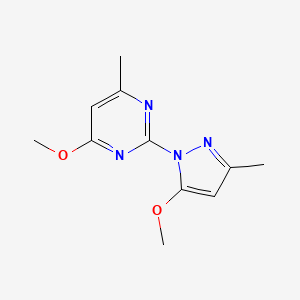
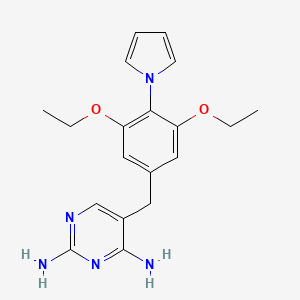
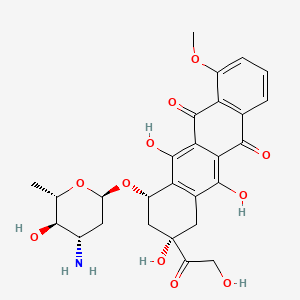
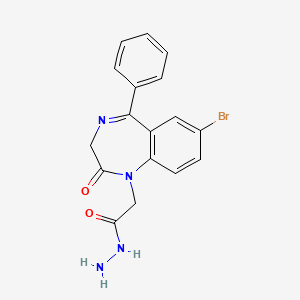
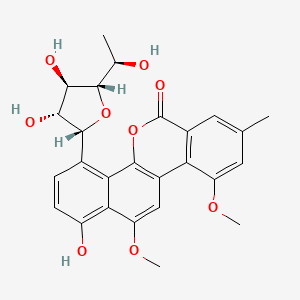
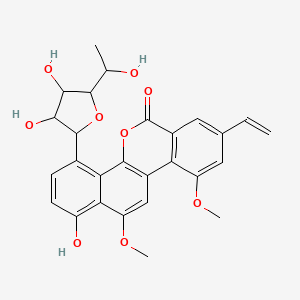
![8-tert-butyl-6,17-dihydroxy-16-methyl-2,4,14,19-tetraoxahexacyclo[8.7.2.01,11.03,7.07,11.013,17]nonadecane-5,15,18-trione](/img/structure/B1671512.png)
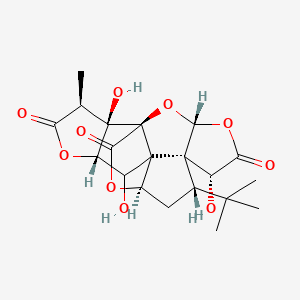
![(1R,3R,6R,7S,8S,9R,10S,11R,12S,13S,16S,17R)-8-tert-butyl-6,9,12,17-tetrahydroxy-16-methyl-2,4,14,19-tetraoxahexacyclo[8.7.2.01,11.03,7.07,11.013,17]nonadecane-5,15,18-trione](/img/structure/B1671514.png)
![(1R,3R,6R,7S,8S,9R,10S,13S,16S,17R)-8-tert-butyl-6,9,17-trihydroxy-16-methyl-2,4,14,19-tetraoxahexacyclo[8.7.2.01,11.03,7.07,11.013,17]nonadecane-5,15,18-trione](/img/structure/B1671515.png)

